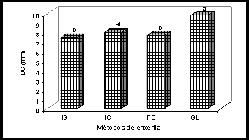ABSTRACT
The tamarind (Tamarindus indica L.) is attracting interest of the South American population due to the beneficial health for the medicinal properties. However , studies with agronomic techniques for the species are scarce. Aiming to determine the best grafting method for the production of plant seedlings of the tamarind, an experiment was conducted in the greenhouse, the Universidade Federal Rural do Semiárido - UFERSA, Mossoró, RN. The design used was a randomized complete block, consisting of five grafting methods (grafting in top cleft, cleft grafting in the top “simple English way”, grafting in the top “complicated English way”, grafting and budding side cleft plate) with seven replicates and each plot with 14 plant seedlings. Variables evaluated were: percentage of grafting take, shoot length, root length, branches length, leaves number, branches number, stem diameter, shoot dry matter, root dry matter, total dry matter. The data were subjected to variance analysis and compared by Tukey test at 5% significance. The methods grafting in top cleft, grafting in the top “complicated English way” and grafting in the top “simple English way”, are, respectively, the best grafting methods for the tamarind.
Key words:
exotic fruit growing; family leguminosae; seedling quality

 Thumbnail
Thumbnail
 Thumbnail
Thumbnail
 Thumbnail
Thumbnail
 Thumbnail
Thumbnail
 Thumbnail
Thumbnail
 Thumbnail
Thumbnail





